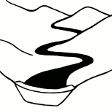Piggery-Banana-Coffee technology
(អ៊ូហ្គង់ដា)
Obusa bwe mbizzi kumwanyi ne bitooke
ការពណ៌នា
The "Piggery-Banana-Coffee" sustainable land management technology is a proven practice that significantly improves soil fertility and productivity in an integrated farming system for smallholder farmers in Uganda.
The “piggery-banana-coffee” SLM technology has been widely practiced by smallholders in Bukumansimbi District, Central Uganda for many years. The technology is proven due to its manifold functions and benefits, including increased productivity and improved soil biodiversity leading to better food security with organic, healthy produce. It simultaneously contributes to environmental protection. The technology has been applied for many years in Bukumansimbi but it needed a promotion by the implementer Caritas MADDO for wider adaption by the community.
The technology can be applied in a natural environmental setting with no controlled conditions. Taking a case of one acre (0.4 ha) of land the farmer will need 450 coffee seedlings and 150 banana suckers to establish an integrated banana-coffee plantation. Then there is a requirement for 10 pigs to supply enough manure (urine and dung) to maintain the fertility of the soil in the plantation. Bananas provide shade to the coffee and reduce the impact of wind and soil erosion. Manure from the piggery is applied to the mixed plantation. Manure application increases soil biodiversity and improves both the physical and chemical properties of the soil, including soil structure, aeration, and moisture retention. Integrating piggery components into the system requires shed construction, purchase of piglets, feeding costs, treatment, and vaccinations. The pigsty occupies a space of 50 ft by 25 ft (approx. 15 m x 7.5 m). Each enterprise is complementary to the other: manure from pigs goes to the coffee and banana plantation and in return the banana peelings as well as the household food leftovers are served as important food resources for the pigs.
The land users under the pilot project acknowledge the significance of the technology because of its ability to sustain production and the other benefits listen above. However, swine fever disease is one of the limiting factors to the technology, as the pigs are prone to its outbreak. Moreover, some farmers report the high feeding costs for the pigs’ maintenance - particularly in the dry season (when there are few weeds that can be supplemented to the diet of the pigs).
ទីតាំង
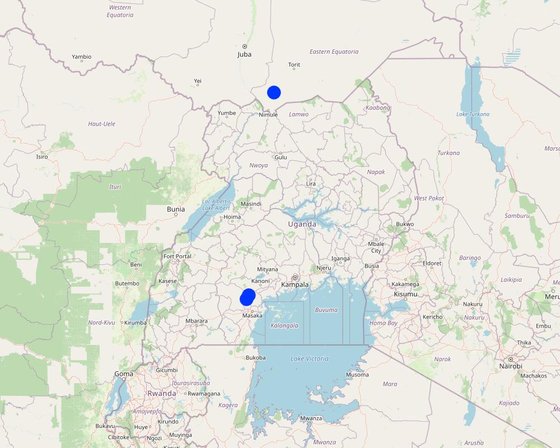
ទីតាំង: Bigasa Sub County in Bukomansimbi District, Central region, អ៊ូហ្គង់ដា
ចំនួនទីកន្លែងបច្ចេកទេស ដែលវិភាគ: 10-100 កន្លែង
ចំណុចយោងភូមិសាស្ត្រនៃទីតាំងជ្រើសរើស
-
32.16797, 3.94827
-
31.62506, -0.09484
-
31.66738, -0.02196
ការសាយភាយនៃបច្ចេកទេស: ត្រូវបានផ្សព្វផ្សាយត្រឹមតំបន់មួយ (approx. 0.1-1 គម2)
តើស្ថិតក្នុងតំបន់ការពារអចិន្ត្រៃយ៍?: ទេ
កាលបរិច្ឆេទនៃការអនុវត្ត: 2017; តិចជាង 10ឆ្នាំមុន (ថ្មី)
ប្រភេទនៃការណែនាំឱ្យអនុវត្តន៍៖
-
តាមរយៈការបង្កើតថ្មីរបស់អ្នកប្រើប្រាស់ដី
-
ជាផ្នែកនៃប្រព័ន្ធប្រពៃណី (> 50 ឆ្នាំ)
-
ពេលកំពុងពិសោធន៍
-
តាមរយៈគម្រោង / អន្តរាគមន៍ពីខាងក្រៅ
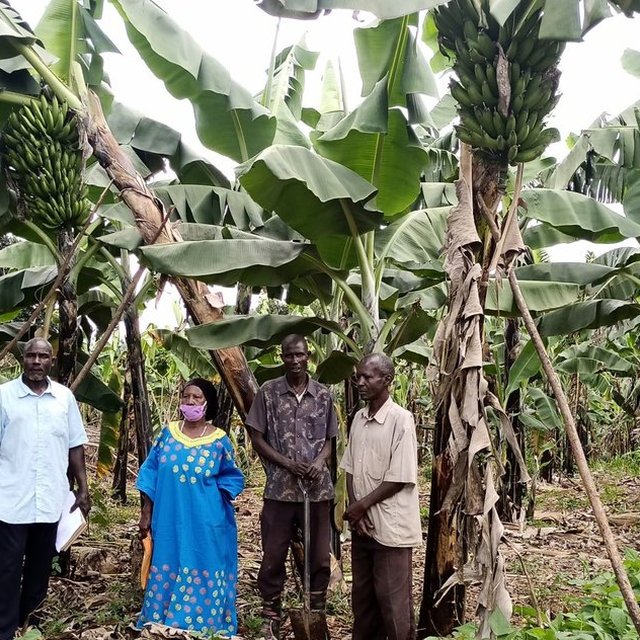
Participants in the banana plantation (Nabukenya, Beatrice)
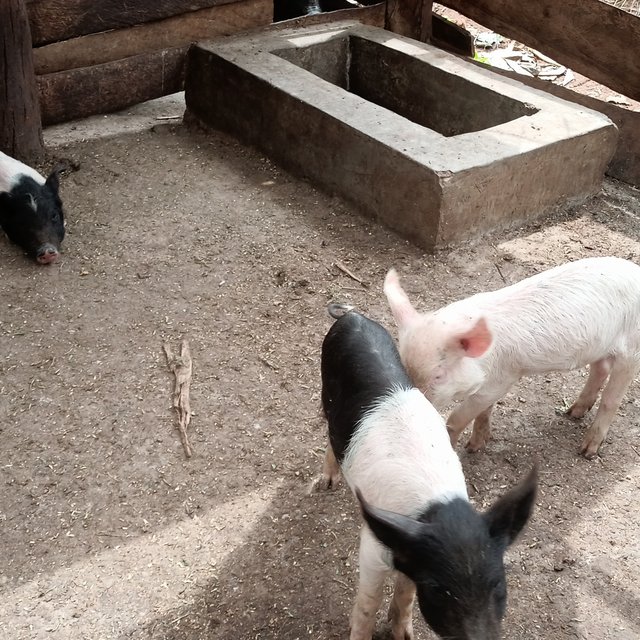
Piglets in a newly established piggery (Nabukenya, Beatrice)
គោលបំណងចម្បងៗ
-
ធ្វើឱ្យប្រសើរឡើងនូវផលិតកម្ម
-
កាត់បន្ថយ, បង្ការ, ស្តារឡើងវិញនូវការធ្លាក់ចុះគុណភាពដី
-
អភិរក្សប្រព័ន្ធអេកូឡូស៊ី
-
ការពារតំបន់ទីជម្រាល/តំបន់ខ្សែទឹកខាងក្រោមបញ្ចូលជាមួយបច្ចេកទេសផ្សេងទៀត
-
អភិរក្ស/ធ្វើឱ្យប្រសើរឡើងជីវចម្រុះ
-
កាត់បន្ថយហានិភ័យនៃគ្រោះមហន្តរាយ
-
បន្ស៊ាំទៅនឹងការប្រែប្រួលអាកាសធាតុ/គ្រោះមហន្តរាយ និងផលប៉ះពាល់របស់វា
-
កាត់បន្ថយការប្រែប្រួលអាកាសធាតុ និងផលប៉ះពាល់របស់វា
-
បង្កើតផលប្រយោជន៍សេដ្ឋកិច្ច
-
បង្កើតផលប្រយោជន៍សង្គម
ការប្រើប្រាស់ដី
ដីប្រើប្រាស់ចម្រុះនៅលើដីតែមួយ បាទ/ចា៎ - កសិរុក្ខកម្ម
-
ដីដាំដំណាំ
- ដំណាំរយៈពេលវែង (មិនមែនឈើ): ចេក/plantain/abaca, Coffee
ចំនួនសារដែលដាំដំណាំក្នុងមួយឆ្នាំ: 2
តើជាការអនុវត្តន៍ដំណាំចន្លោះ? បាទ/ចា៎
តើជាការអនុវត្តន៍ដំណាំវិលជុំ? ទេ
-
ដីព្រៃ/ដីដាំដើមឈើ
- ការដាំដើមឈើ ការដាំព្រៃឡើងវិញ. ពូជ៖ពូជបញ្ចូលគ្នា
Tree types (ព្រៃស្រោង): មិនមាន
ផលិតផល និងសេវាកម្ម: ឈើហ៊ុប, អុស, ផលិតផលព្រៃផ្សេងៗ , វាលស្មៅ, ការអភិរក្ស/ការការពារធម្មជាតិ, ការកំសាន្ត/ទេសចរណ៍, ការពារពីគ្រោះធម្មជាតិ, Backcloth
-
ផ្លូវទឹក ផ្ទៃទឹក ដីសើម - វាលភក់ ដីសើម
ផលិតផល/សេវាកម្មចម្បង: Swamp is nearby for water supply
ការផ្គត់ផ្គង់ទឹក
-
ទឹកភ្លៀង
-
ទឹកភ្លៀង និងប្រព័ន្ធស្រោចស្រព
-
ប្រព័ន្ធស្រោចស្រពទាំងស្រុង
គោលបំណងទាក់ទងនឹងការធ្លាក់ចុះគុណភាពដី
-
ការការពារការធ្លាក់ចុះគុណភាពដី
-
ការកាត់បន្ថយការធ្លាក់ចុះគុណភាពដី
-
ការជួសជុល/ ស្តារឡើងវិញនៃឱនភាពដីធ្ងន់ធ្ងរ
-
ការបន្ស៊ាំទៅនឹងការធ្លាក់ចុះគុណភាពដី
-
ដែលមិនអាចអនុវត្តបាន
ប្រភេទនៃការធ្លាក់ចុះគុណភាពដីដែលបានដោះស្រាយ
-
ការហូរច្រោះដីដោយសារទឹក - Wt: ការបាត់ដីស្រទាប់លើដោយការហូរច្រោះ, Wo: ផលប៉ះពាល់នៃការធ្លាក់ចុះគុណភាពកន្លែងឆ្ងាយ
-
ការធ្លាក់ចុះសារធាតុគីមីក្នុងដី - Cp: ការបំពុលដី
-
ការធ្លាក់ចុះជីវសាស្ត្រនៃដី - Bq: ការថយចុះនូវជីវម៉ាស/ បរិមាណ, Bs: សមាសភាពដែលមានគុណភាពនិងប្រភេទសត្វ/ការថយចុះនូវជីវចម្រុះ, Bl: ការបាត់បង់មីក្រូ និងម៉ាក្រូសរីរាង្គរបស់ដី, Bp: ការកើនឡើងនូវសត្វល្អិត ឬជំងឺ បាត់បង់នូវសត្វមានប្រយោជន៍
-
ការបាត់បង់ទឹក - Hq: ការថយចុះគុណភាពទឹកនៅក្រោមដី
ក្រុម SLM
-
កសិរុក្ខកម្ម
-
ការគ្រប់គ្រងដោយរួមបញ្ចូលការដាំដំណាំ និងការចិញ្ចឹមសត្វ
-
ការគ្រប់គ្រងជីជាតិដីតាមបែបចម្រុះ
វិធានការ SLM
-
វិធានការក្សេត្រសាស្ត្រ - A1: ដំណាំ/គម្របដី, A2: សារធាតុសរីរាង្គ/ជីជាតិដី, A3: ការរក្សាស្រទាប់ដីខាងលើ (A 3.2: Reduced tillage (> 30% soil cover)), A7: ផ្សេងៗ
-
វិធានការរុក្ខជាតិ - V1: ឈើធំៗ និងដើមឈើតូចៗ , V2: ស្មៅនិងរុក្ខជាតិៗដែលដុះមានអាយុមិនលើសពី 2ឆ្នាំ , V3: ការកាប់ឆ្ការរុក្ខជាតិ
-
វិធានការរចនាស័ម្ពន្ធ - S1: ការធ្វើដីថ្នាក់ៗតាមជម្រាលភ្នំ , S9: រោងដំណាំ និងរោងចិញ្ចឹមសត្វ
គំនូរបច្ចេកទេស
លក្ខណៈបច្ចេកទេស
Technical specifications of the pig sty construction
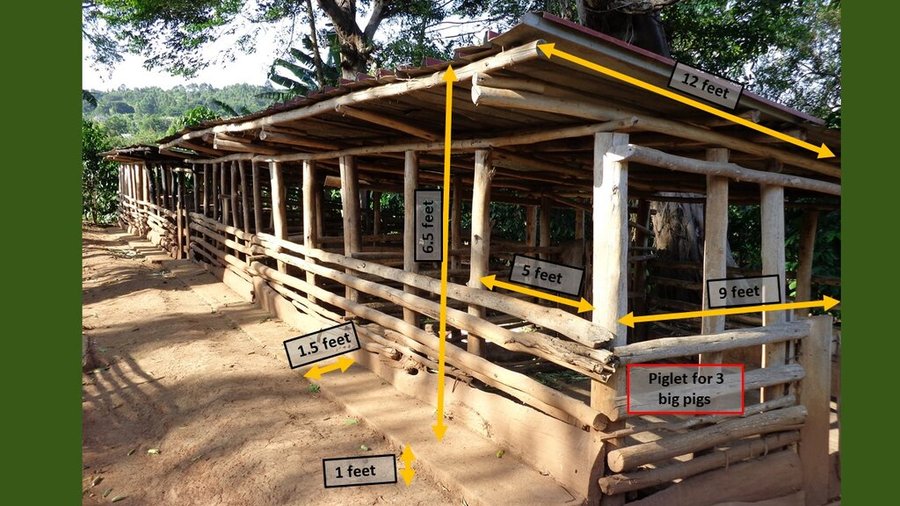
Author: Kyambadde, Tonny
Technical specifications of the coffee and banana integration
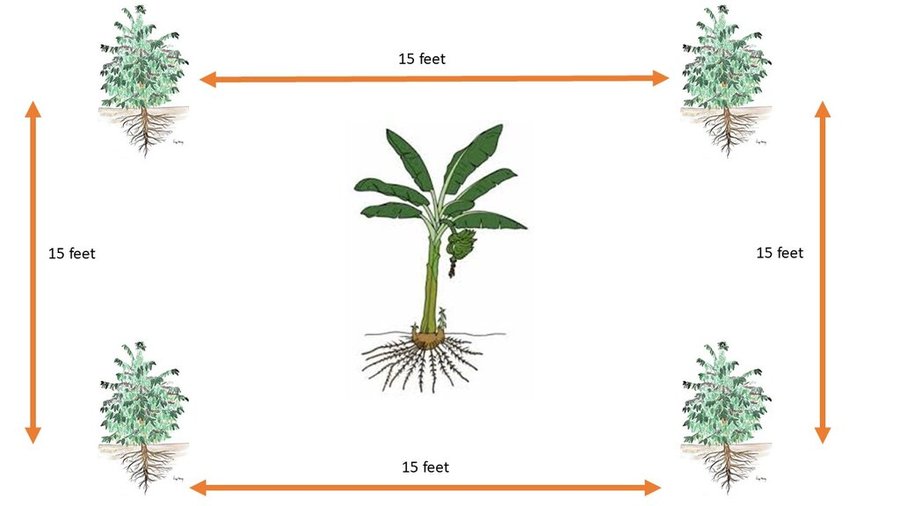
Author: Kyambadde, Tonny
ការបង្កើតនិងការថែទាំ៖ សកម្មភាព ធាតុចូល និងថ្លៃដើម
ការគណនាធាតុចូល និងថ្លៃដើម
- ថ្លៃដើមត្រូវបានគណនា៖ ក្នុងតំបន់អនុវត្តបច្ចេកទេស (ទំហំ និងឯកត្តាផ្ទៃដី៖ one hectare)
- រូបិយប័ណ្ណសម្រាប់ការគណនាថ្លៃដើម៖ Uganda Shilling
- អត្រាប្តូរប្រាក់ (ទៅជាដុល្លារអាមេរិក)៖ 1 USD = 3750.0 Uganda Shilling
- ថ្លៃឈ្នួលជាមធ្យមក្នុង ១ ថ្ងៃ៖ no labour was hired
កត្តាសំខាន់បំផុតដែលមានឥទ្ធិពលលើថ្លៃដើម
Most costs are connected to the piggery in particular the maintenance of the pigs. Animal diseases and the resulting costs for the treatments are unplanned expenses.
សកម្មភាពបង្កើតបច្ចេកទេស
-
Land clearing and preparation (ពេលវេលា/ ភាពញឹកញាប់: once a year)
-
Hole digging (ពេលវេលា/ ភាពញឹកញាប់: once)
-
Coffee and banana planting (ពេលវេលា/ ភាពញឹកញាប់: once)
-
Pig sty (house) construction (ពេលវេលា/ ភាពញឹកញាប់: once)
-
Purchase of pigs (ពេលវេលា/ ភាពញឹកញាប់: once)
ថ្លៃបង្កើតបច្ចេកទេសសរុប (ប៉ាន់ស្មាន)
5300000,0
សកម្មភាពថែទាំ
-
Weeding and garden clearing (ពេលវេលា/ ភាពញឹកញាប់: Twice a seaon)
-
Manure application (ពេលវេលា/ ភាពញឹកញាប់: At the onset of rain season)
-
Feeding and watering of pigs (ពេលវេលា/ ភាពញឹកញាប់: On daily basis)
-
Treatment and deworming of pigs (ពេលវេលា/ ភាពញឹកញាប់: On monthly basis)
-
Mulching of the garden (ពេលវេលា/ ភាពញឹកញាប់: Once a year or more)
-
Contour digging (ពេលវេលា/ ភាពញឹកញាប់: once a year)
-
Pruning of coffee and banana plantation (ពេលវេលា/ ភាពញឹកញាប់: For banana its done twice a season and for coffee its done every after harvesting season.)
-
Maintenance of piggery sty (ពេលវេលា/ ភាពញឹកញាប់: once a year)
ថ្លៃថែទាំបច្ចេកទេសសរុប (ប៉ាន់ស្មាន)
500000,0
បរិស្ថានធម្មជាតិ
បរិមាណទឹកភ្លៀងជាមធ្យមប្រចាំឆ្នាំ
-
< 250 មម
-
251-500 មម
-
501-750 មម
-
751-1,000 មម
-
1,001-1,500 មម
-
1,501-2,000 មម
-
2,001-3,000 មម
-
3,001-4,000 មម
-
> 4,000 មម
តំបន់កសិអាកាសធាតុ
-
សើម
-
មានភ្លៀងមធ្យម
-
មានភ្លៀងតិចតួច
-
ស្ងួត
លក្ខណៈសម្គាល់នៃអាកាសធាតុ
បរិមាណទឹកភ្លៀងជាមធ្យមប្រចាំឆ្នាំគិតជា មម៖ 1200.0
The rainfall pattern is bimodal, having two seasons. The two dry spell seasons are between January - March and between June to August, with the winter seasons between March to May and September to December.
ស្ថានីយឧតុនិយម៖ Uganda metrological authority
The average maximum temperature doesn't exceed 30 degrees Celcius and the minimum temperature is not below 10 degrees Celcius with almost equal length of the day and night through out the year.
The humidity level is relatively low through out the area.
ជម្រាល
-
រាបស្មើ (0-2%)
-
ជម្រាលតិចតួច (3-5%)
-
មធ្យម (6-10%)
-
ជម្រាលខ្ពស់បន្តិច (11-15%)
-
ទីទួល (16-30%)
-
ទីទួលចោត (31-60%)
-
ទីទួលចោតខ្លាំង (>60%)
ទម្រង់ដី
-
ខ្ពង់រាប
-
កំពូលភ្នំ
-
ជម្រាលភ្នំ
-
ជម្រាលទួល
-
ជម្រាលជើងភ្នំ
-
បាតជ្រលងភ្នំ
រយៈកម្ពស់ធៀបនឹងនីវ៉ូទឹកសមុទ្រ
-
0-100 ម
-
101-500 ម
-
501-1,000 ម
-
1,001-1,500 ម
-
1,501-2,000 ម
-
2,001-2,500 ម
-
2,501-3,000 ម
-
3,001-4,000 ម
-
> 4,000 ម
បច្ចេកទេសត្រូវបានអនុវត្តនៅក្នុង
-
សណ្ឋានដីប៉ោង
-
សណ្ឋានដីផត
-
មិនពាក់ព័ន្ធទាំងអស់
ជម្រៅដី
-
រាក់ខ្លាំង (0-20 សម)
-
រាក់ (21-50 សម)
-
មធ្យម (51-80 សម)
-
ជ្រៅ (81-120 សម)
-
ជ្រៅខ្លាំង (> 120 សម)
វាយនៈភាពដី (ដីស្រទាប់ខាងលើ)
-
គ្រើម/ មានពន្លឺ (ខ្សាច់)
-
មធ្យម (ល្បាយ, ល្បាប់)
-
ម៉ត់/ ធ្ងន់ (ឥដ្ឋ)
វាយនភាពដី (> 20 សម ក្រោមស្រទាប់លើ)
-
គ្រើម/ មានពន្លឺ (ខ្សាច់)
-
មធ្យម (ល្បាយ, ល្បាប់)
-
ម៉ត់/ ធ្ងន់ (ឥដ្ឋ)
កម្រិតសារធាតុសរីរាង្គក្នុងដីស្រទាប់លើ
-
ខ្ពស់ (>3%)
-
មធ្យម (1-3%)
-
ទាប (<1%)
ដង្ហើមទឹកក្នុងដី
-
ផ្ទៃខាងលើ
-
< 5 ម
-
5-50 ម
-
> 50 ម
ភាពអាចរកបាននៃទឹកលើដី
-
លើស
-
ល្អ
-
កម្រិតមធ្យម
-
មិនមាន/ គ្មាន
គុណភាពទឹក (មិនបានធ្វើប្រព្រឹត្តិកម្ម)
-
ទឹកពិសារដែលមានគុណភាពល្អ
-
ទឹកពិសារដែលគ្មានគុណភាព (តម្រូវឱ្យមានការសំអាត)
-
ទឹកសម្រាប់តែការធ្វើកសិកម្ម (ស្រោចស្រព)
-
ទឹកមិនអាចប្រើប្រាស់បាន
គុណភាពទឹក គឺផ្តោតទៅលើ៖ ទាំងទឹកក្រោមដី និងលើផ្ទៃដី
តើមានបញ្ហាទឹកប្រៃហូរចូលដែរឬទេ?
ការកើតឡើងនៃទឹកជំនន់
ភាពសំបូរបែបនៃជម្រកធម្មជាតិ
ចរិតលក្ខណៈរបស់អ្នកប្រើប្រាស់ដីដែលប្រើបច្ចេកទេស SLM
ទីផ្សារ
-
សម្រាប់ហូបក្នុងគ្រួសារ (ផ្គត់ផ្គង់ខ្លួនឯង)
-
ពាក់កណ្តាលពាណិជ្ជកម្ម (ផ្គត់ផ្គង់ខ្លួនឯង/ ពាណិជ្ជកម្ម)
-
ពាណិជ្ជកម្ម/ ទីផ្សារ
ចំណូលក្រៅកសិដ្ឋាន
-
តិចជាង 10% នៃចំណូល
-
10-50% នៃចំណូល
-
ច្រើនជាង 50% នៃចំណូល
កម្រិតជីវភាព
-
មិនល្អខ្លាំង
-
មិនល្អ
-
មធ្យម
-
មាន
-
មានខ្លាំង
កម្រិតនៃការប្រើគ្រឿងយន្ត
-
ប្រើកម្លាំងពលកម្ម
-
ប្រើកម្លាំងសត្វ
-
គ្រឿងយន្ត/ ម៉ាស៊ីន
នៅមួយកន្លែង ឬពនេចរ
-
នៅមួយកន្លែង
-
ពាក់កណ្តាលពនេចរ
-
ពនេចរ
បុគ្គល ឬក្រុម
-
ធ្វើខ្លួនឯង/ គ្រួសារ
-
ជាក្រុម/ សហគមន៍
-
សហករ
-
មានបុគ្គលិក (ក្រុមហ៊ុន, រដ្ឋ)
អាយុ
-
កុមារ
-
យុវវ័យ
-
វ័យកណ្តាល
-
មនុស្សចាស់
ផ្ទៃដីប្រើប្រាស់ក្នុងមួយគ្រួសារ
-
< 0.5 ហិកតា
-
0.5-1 ហិកតា
-
1-2 ហិកតា
-
2-5 ហិកតា
-
5-15 ហិកតា
-
15-50 ហិកតា
-
50-100 ហិកតា
-
100-500 ហិកតា
-
500-1,000 ហិកតា
-
1,000-10,000 ហិកតា
-
> 10,000 ហិកតា
មាត្រដ្ឋាន
-
ខ្នាតតូច
-
ខ្នាតមធ្យម
-
ខ្នាតធំ
ភាពជាម្ចាស់ដីធ្លី
-
រដ្ឋ
-
ក្រុមហ៊ុន
-
ភូមិ
-
ក្រុម
-
ឯកជន មិនមានកម្មសិទ្ធ
-
ឯកជន មានកម្មសិទ្ធ
សិទ្ធិប្រើប្រាស់ដី
-
អាស្រ័យផលសេរី (មិនមានការកំណត់)
-
ជាក្រុម (មានដែនកំណត់)
-
កិច្ចសន្យាជួល
-
ឯកជន
សិទ្ធិប្រើប្រាស់ទឹក
-
អាស្រ័យផលសេរី (មិនមានការកំណត់)
-
ជាក្រុម (មានដែនកំណត់)
-
កិច្ចសន្យាជួល
-
ឯកជន
ប្រើប្រាស់សេវាកម្ម និងហេដ្ឋារចនាសម្ព័ន្ធ
ការងារ (ឧ. ការងារក្រៅកសិដ្ឋាន)
ផលប៉ះពាល់
ផលប៉ះពាល់សេដ្ឋកិច្ចសង្គម
ផលិតកម្មដំណាំ
គុណភាពមុន SLM: 1
គុណភាពក្រោយ SLM: 3
Significant improvement in coffee production was noticed jumping from an average yield increase of 300kg to 700kg of coffee harvest in one acre per season. Size of banana bunches with an average increase in weight from from 12kg to 30kg.
គុណភាពដំណាំ
គុណភាពមុន SLM: 0
គុណភាពក្រោយ SLM: 2
Coffee beans improved a lot in terms of size and quality, with over 70% coffee beans harvested in the category of screen 18 (super beans). The banana size and its fingers improved in size, and the taste of banana food greatly improve with a pleasant aroma, softer on eating and cooks faster compared to previously produced bananas.
ផលិតកម្មសត្វ
The production of pigs increased substantially in a time period of a year. The participating farmers started with 3 pigs at the beginning and reached an increase of pigs to an average 15 pigs after a year (2 breeding cycles per pig per year).
ការគ្រប់គ្រងដី
គុណភាពមុន SLM: -2
គុណភាពក្រោយ SLM: 3
The farming system employed by the farmers previously before introduction of the technology was not sustainable. Resources were being continuously depleted by crop practices employed without replacement of what is lost from the soil during harvest. integration of piggery into the system improved soil fertility with manure composted from piggery wastes. Besides boosting soil fertility, biodiversity on the farm improved as well (the soil organisms, new plant species emerged, insect species among others) the green biomass and overall soil health improved.
ចំណូលក្នុងកសិដ្ឋាន
The average farm income before the technology was very little and did not support the family's basic home needs. With the introduction of the technology, the household income improved from an average of monthly 45.000 UGX to 150.000 UGX. However, it is important to note that this is not a fixed monthly income and is depending on the harvest season. Thus, there are peak income phases followed by low seasons.
ភាពសម្បូរបែបប្រភពប្រាក់ចំណូល
More income sources were established through the three enterprises (coffee, banana and piggery).
ផលប៉ះពាល់វប្បធម៌សង្គម
សន្តិសុខស្បៀង/ ភាពគ្រប់គ្រាន់ខ្លួនឯង
គុណភាពមុន SLM: 0
គុណភាពក្រោយ SLM: 2
With improved soil fertility resulting in bigger sizes of banana bunches, improved food security was achieved. The increased income from coffee and piggery ensured availability of alternative food supply though their sale.
ចំណេះដឹង SLM / ការធ្លាក់ចុះគុណភាពដី
Through the technology farmers were able to learn how important it is to use organic sources of fertilizer and its benefits to the environment and soil health. MADDO facilitated roughly 15 different training sessions for the participating farmer group targeting the soil and water conservation practices.
ស្ថានភាពក្រុមទទួលផលតិចពីសេដ្ឋកិច្ច និងសង្គម (ភេទ អាយុ ជាតិសាសន៍ ។ល។)
អាក្រក់ជាងមុន
ប្រសើរជាងមុន
The situation of women (average between 40-55 years old) was improved through the technology by giving them access and knowledge to this pilot project. The mobilization and right selection of participants were crucial for the improvement.
ផលប៉ះពាល់លើអេកូឡូស៊ី
សំណើមដី
Higher retention of soil moisture
សារធាតុសរីរាង្គដី/ការបូនក្រោមដី
Better composition of soil nutrients with increased population of soil organisms (micro and macro)
ភាពសម្បូរបែបនៃទីជំរក
Organic manure provided a conducive environment for multiplication and survival of living organisms
ផលប៉ះពាល់ក្នុងបរិវេណ
Pollution of water
The usage of organic manure instead of chemical fertilizers reduced the pollution of downstream water from fields
ការវិភាគថ្លៃដើម និងអត្ថប្រយោជន៍
អត្ថប្រយោជន៍បើប្រៀបធៀបនឹងថ្លៃដើមក្នុងការបង្កើតបច្ចេកទេស
រយៈពេលខ្លី
អវិជ្ជមានខ្លាំង
វិជ្ជមានខ្លាំង
រយៈពេលវែង
អវិជ្ជមានខ្លាំង
វិជ្ជមានខ្លាំង
អត្ថប្រយោជន៍បើប្រៀបធៀបនឹងថ្លៃដើមក្នុងការថែទាំបច្ចេកទេស
រយៈពេលខ្លី
អវិជ្ជមានខ្លាំង
វិជ្ជមានខ្លាំង
រយៈពេលវែង
អវិជ្ជមានខ្លាំង
វិជ្ជមានខ្លាំង
ការទទួលយក និងការបន្ស៊ាំ
ភាគរយនៃអ្នកប្រើប្រាស់ដីនៅតំបន់ដែលបានទទួលយកបច្ចេកទេស
-
តែមួយករណី /ពិសោធន៍
-
1-10%
-
11-50%
-
> 50%
ក្នុងចំណោមអ្នកទទួលយកបច្ចេកទេសនេះ តើមានប៉ុន្មានភាគរយដែលបានអនុវត្តន៍ដោយមិនបានទទួលការលើកទឹកចិត្តជាសម្ភារៈ?
-
0-10%
-
11-50%
-
51-90%
-
91-100%
ចំនួនខ្នងផ្ទះ និង/ឬតំបន់ដែលគ្របដណ្តប់
Mainstreaming of the technology was promoted through copying from the participants and also due to the promotion by the district field staff. The technology has been in existence for years and that is why a high adoption can be observed.
តើថ្មីៗនេះ បច្ចេកទេសនេះត្រូវបានកែតម្រូវដើម្បីបន្ស៊ាំទៅនឹងស្ថានភាពប្រែប្រួលដែរឬទេ?
ចំពោះលក្ខខណ្ឌប្រែប្រួលណាមួយដែលត្រូវបានបន្ស៊ាំ?
-
ការប្រែប្រួលអាកាសធាតុ/គ្រោះមហន្តរាយធម្មជាតិ
-
បម្រែបម្រួលទីផ្សារ
-
កម្លាំងពលកម្មដែលអាចរកបាន (ចំណាកស្រុក)
សេក្តីសន្និដ្ឋាន និងមេរៀនបទពិសោធន៍
ភាពខ្លាំង: ទស្សនៈអ្នកប្រើប្រាស់ដី
-
Contributes positively to the soil fertility.
-
Improves the food security and household income
ភាពខ្លាំង: ទស្សនៈរបស់អ្នកចងក្រង ឬបុគ្គលសំខាន់ផ្សេងទៀត
-
Farmers were able to local available resources for this technology.
-
It improved the soil health and contributed to environmental conservation.
ចំណុចខ្សោយ/ គុណវិបត្តិ/ ហានិភ័យ : ទស្សនៈអ្នកប្រើប្រាស់ដីវិធីដោះស្រាយ
-
Diseases that affect the piggery (swine fewer).
No mitigation (vaccination) available.
-
The vet officers are not always available for vaccinations or treatments for the pigs. Moreover, there are quite expensive.
Farmers group together to lobby for the service.
ចំណុចខ្សោយ/ គុណវិបត្តិ/ ហានិភ័យ : ទស្សនៈរបស់អ្នកចងក្រង ឬបុគ្គលសំខាន់ផ្សេងទៀតវិធីដោះស្រាយ
-
Follow up on the management practices for the piggery were time consuming.
Establishment of community-based trainers (CBT) that take over
ឯកសារយោង
Editors
-
Beatrice Nabukenya
-
Michael Mulindwa
-
Kyagaba Prossy
-
Annika Reimann
អ្នកត្រួតពិនិត្យ
-
William Critchley
-
Rima Mekdaschi Studer
កាលបរិច្ឆេទនៃការអនុវត្ត: 18 ខែ ឧសភា ឆ្នាំ 2021
កែតម្រូវចុងក្រោយ: 16 ខែ វិច្ឆិកា ឆ្នាំ 2023
បុគ្គលសំខាន់ៗ
-
Tonny Kyambadde - co-compiler
-
Prossy Kyagaba - co-compiler
-
Beatrice Nabukenya - co-compiler
-
Michael Mulindwa - co-compiler
ការពណ៌នាលម្អិតក្នុងប្រព័ន្ធគ្រប់គ្រងទិន្នន័យរបស់វ៉ូខេត
ឯកសារនេះត្រូវបានសម្របសម្រួលដោយ
ស្ថាប័ន៖
- Caritas Masaka Diocesan Development Organisation (Caritas MADDO) - អ៊ូហ្គង់ដា
គម្រោង
- Euregio-East Africa Livelihood Improvement Programme (EEALIP)
ឯកសារយោងសំខាន់ៗ
-
Benefits of sustainable land management, UNCCD: https://catalogue.unccd.int/838_Benefits_of_SLM_eng.pdf
ការភ្ជាប់ទៅកាន់ពត៌មានពាក់ព័ន្ធលើប្រព័ន្ធអនឡាញ









